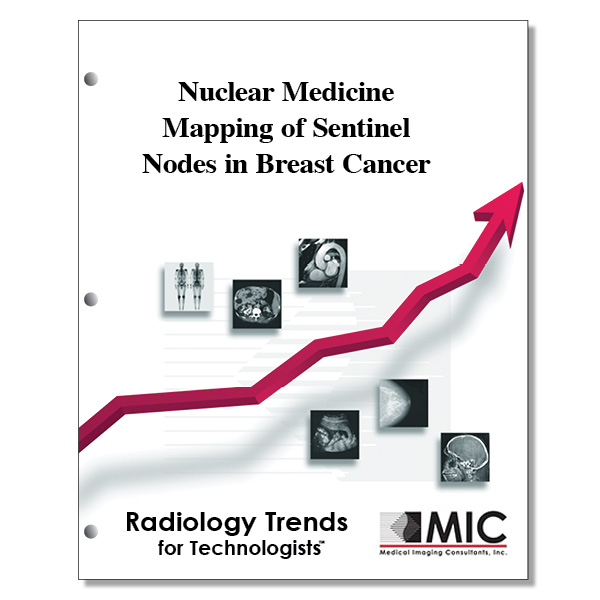

Nuclear Medicine Mapping of Sentinel Nodes in Breast Cancer
A review of the sentinel node biopsy used to check for nodal involvement in breast cancer.
Course ID: Q00324 Category: Radiology Trends for Technologists Modalities: Mammography, Nuclear Medicine2.75 |
Satisfaction Guarantee |
$29.00
- Targeted CE
- Outline
- Objectives
Targeted CE per ARRT’s Discipline, Category, and Subcategory classification for enrollments starting after June 11, 2024:
[Note: Discipline-specific Targeted CE credits may be less than the total Category A credits approved for this course.]
Breast Sonography: 0.50
Patient Care: 0.50
Patient Interactions and Management: 0.50
Mammography: 1.25
Procedures: 1.25
Mammographic Positioning, Special Needs, and Imaging Procedures: 1.25
Magnetic Resonance Imaging: 0.75
Procedures: 0.75
Body: 0.75
Nuclear Medicine Technology: 2.25
Patient Care: 0.25
Patient Interactions and Management: 0.25
Procedures: 2.00
Other Imaging Procedures: 2.00
Registered Radiologist Assistant: 2.75
Safety: 0.75
Patient Safety, Radiation Protection, and Equipment Operation: 0.75
Procedures: 2.00
Thoracic Section: 2.00
Sonography: 0.75
Procedures: 0.75
Superficial Structures and Other Sonographic Procedures: 0.75
Radiation Therapy: 2.00
Patient Care: 1.00
Patient and Medical Record Management: 1.00
Procedures: 1.00
Treatment Sites and Tumors: 1.00
Outline
- Introduction
- SNB Strategy and Surgical Morbidity
- Locoregional Recurrence and Survival
- Alarming Results Concerning False-negative Rate
- Optimization of SNM Procedure
- Impact of Prior Excisional Biopsy on False-Negative Rate
- Importance of Dual Mapping
- Resection of All Hot or Blue Nodes
- Effect of a Different Injection Site for Radiotracer and Blue Dye on False-E. Negative Rate
- Improvement of SNB Procedure Through Lymphoscintigraphy
- SNB in Patients at High Risk of Nodal Involvement
- SNB in Various Categories of Tumor Size
- SNB in Patients with Multiple Simultaneous Ipsilateral Carcinomas
- SNB After Neoadjuvant Chemotherapy
- Safety Measures in Patients with High Probability of Axillary Involvement
- Internal Mammary Drainage: Potential Impact on Decisions About Radiotherapy
- Probability of Internal Mammary Involvement in Patients with Internal Mammary Drainage According to Axilla Sentinel Node Status
- Patients with Internal Mammary Drainage and Negative Axillary Sentinel Node
- SNB and Some Controversial Issues
- Prognostic Significance of Micrometastases and Isolated Tumor Cell Clusters
- Alternatives to Routine ALND in Patients with Positive Sentinel Node
- SNB After Aesthetic Breast Surgery
- SNB and Pregnancy
- SNB in Ductal Carcinoma in Situ
- Research Areas in Lymphatic Mapping
- Axillary Reverse Mapping (ARM
- SNB and Concomitant Probe-Guided Excision of Nonpalpable Breast Cancer
- Intraoperative Imaging
- Conclusion
Objectives
Upon completion of this course, students will:
- describe the major prognostic factor in early stage breast cancer
- know the risk of axillary lymph node dissection
- know the advantage of sentinel node biopsy
- be familiar with the imaging tools for SNB
- know the reason for the use of radiopharmaceuticals for SNB
- be familiar with the risk factors when using blue dye
- know that SNB is associated with lower risk than ALND
- know that SNB is associated with lower incidence of recurrence
- know the standards of ASCO for successful SNB (without completion ALND)
- define and understand the importance of identification rate
- define false-negative rate and know the difference from identification rate
- know that uninvolved lymph nodes have no impact on the false-negative rate
- understand that previous surgery impacts the false-negative rate
- know that different dyes are used in various countries & especially what is used in the USA
- state the specific radiotracer used in Europe
- define the standard of resection of lymph nodes for SNB
- know that the site of injection affects results of SNB
- recognize the advantage of lymphoscintigraphy
- know that tumor size affects the rate of missed disease resulting in need for completion ALND
- understand why SNB after chemotherapy is not advocated
- recognize the value of ultrasonography to minimize morbidity due to ALND
- indentify when intra-operative pathology assessment is recommended
- state the reason for the controversy surrounding the choice of treatment of internal mammary lymph nodes
- identify the importance of lymphoscintigraphy in imaging the internal mammary drainage
- explain the impact of the result of positive IM involvement and how it influences treatment management
- know the current recommendations for patients with positive SNB
- recognize the correct risk factors associated with additional lymph node involvement
- understand that pregnant patients need specific management when diagnosed with breast cancer
- know the importance that the tumor pathology/histology has on offering SNB to patients
- understand the most important challenge related to SNB is reduction of false-negatives
